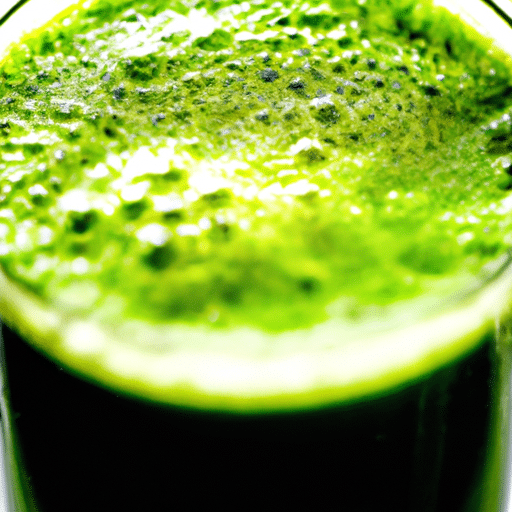Freshly juiced green drinks have become increasingly popular for their health benefits and vibrant flavors. But when it comes to juicing leafy greens like kale and spinach, many people find themselves wondering about the best techniques and tips. In this article, we will share our tried-and-true methods for juicing these nutrient-packed greens, ensuring that you can enjoy every last drop of goodness from these leafy superstars. Whether you’re a juicing newbie or a seasoned pro, get ready to take your green juice game to the next level!
Review contents
Choosing the Right Greens
Freshness and Quality
When it comes to juicing leafy greens, it is essential to select greens that are fresh and of high quality. Look for crisp, vibrant leaves that are free from wilting or yellowing. Ideally, choose organic greens to avoid consuming any pesticides or chemicals. Buying from local farmers or growing your own greens can also ensure maximum freshness and nutrient content.
Types of Leafy Greens
There is a wide variety of leafy greens to choose from when it comes to juicing. Some popular options include kale, spinach, Swiss chard, collard greens, and lettuce. Each green has its own unique flavor profile and nutrient composition, so feel free to experiment and find your favorites. Remember to mix and match greens to maximize the nutritional benefits and overall taste of your juice.
Preparation Before Juicing
Washing the Greens
Before juicing, it is crucial to thoroughly wash your leafy greens to remove any dirt, debris, or potential contaminants. Fill a large bowl with cold water and gently agitate the greens to loosen any dirt. You can also add a splash of white vinegar or lemon juice to the water to help remove any residual pesticides. Rinse the greens under cool running water and pat them dry with a clean towel or use a salad spinner to remove excess moisture.
Removing Stems and Tough Parts
To ensure a smoother and more enjoyable juice, it is recommended to remove the tough stems and any other undesirable parts of the greens. While some greens like kale and chard have thicker stems that can taste bitter, others like spinach have tender stems that can be juiced along with the leaves. Simply use your hands or a sharp knife to separate the leaves from the stems, and discard any tough or damaged portions.
Methods of Juicing
Traditional Juicer
A traditional juicer is a common and convenient option for juicing leafy greens. These machines typically extract juice by grinding and squeezing the greens, separating the pulp from the liquid. Follow the manufacturer’s instructions for assembling and operating the juicer, and feed the greens into the chute gradually to extract the maximum amount of juice. Remember to clean the juicer thoroughly after each use to maintain its performance and hygiene.
Blender Method
If you don’t have a juicer, don’t worry! You can still juice leafy greens using a blender. Although the texture may be slightly different compared to juicing with a traditional juicer, the taste and health benefits are still present. Start by blending the greens with enough water to reach your desired consistency. Once blended, strain the mixture using a fine-mesh sieve or nut milk bag to separate the pulp from the juice. Press the pulp with a spoon to extract as much juice as possible.
Slow Juicer
A slow juicer, also known as a masticating juicer, is another option for juicing leafy greens. This type of juicer operates at a slower speed, which helps to preserve more of the nutrients and enzymes in the greens. The slow juicing process also results in a smoother and less frothy juice. Follow the manufacturer’s instructions for operating the slow juicer, and enjoy the benefits of a nutrient-rich green juice.
Combining Greens with Other Ingredients
Fruit and Vegetable Combinations
To enhance the flavor and nutritional profile of your green juice, consider adding other fruits and vegetables. Fruits like apples, oranges, pineapples, and berries can add a sweet and refreshing taste to balance the earthiness of the greens. Vegetables like carrots, cucumbers, and celery can provide additional nutrients and enhance the overall texture of the juice. Experiment with different combinations to find the perfect balance of flavors that suits your taste buds.
Adding Liquid Base
To facilitate the juicing process and achieve a smoother consistency, it is advisable to add a liquid base to your green juice. Water, coconut water, almond milk, or even green tea can be used as a base. These liquids not only help to extract the juice more effectively but also contribute to the overall hydration and taste of the final product. Adjust the amount of liquid according to your preference, keeping in mind that too much liquid can dilute the flavor of the greens.
Tips for Efficient Juicing
Alternate Green and Non-Green Ingredients
To optimize the juicing process and ensure a well-balanced flavor, it is recommended to alternate between green and non-green ingredients when feeding them into the juicer. This technique helps to prevent clogging and allows the flavors to blend more evenly. For example, if you are juicing kale, follow it with a cucumber or apple to keep the juicing process smooth and efficient.
Chop or Tear the Greens
To further enhance the juicing efficiency, consider chopping or tearing the greens into smaller pieces before juicing. This allows the juicer blades to extract the juice more effectively and reduces the chances of any clogs or jams. While it may require a bit of extra preparation time, the improved juicing process will ultimately result in a higher yield and a more enjoyable juicing experience.
Techniques for Maximizing Juice Yield
Double Juicing Method
If you want to extract every last drop of juice from your leafy greens, you can try the double juicing method. After juicing your greens once, feed the remaining pulp back into the juicer for a second round. This technique helps to extract any remaining juice that may have been missed during the initial juicing process. Keep in mind that the juice obtained from the second round may have a slightly weaker flavor but is still packed with nutrients.
Wrapping Greens around Other Ingredients
Another technique for maximizing juice yield is to wrap the leafy greens around other ingredients before juicing. This method works well for greens like spinach or lettuce, which have a higher water content. Simply place the greens between two other ingredients, such as carrots or cucumbers, before feeding them into the juicer. By doing so, you create a sandwich-like configuration that enhances the juicing process and ensures that the greens are fully utilized.
Variations in Flavor and Texture
Kale Juice
Kale, one of the most popular leafy greens for juicing, offers a rich source of vitamins A, C, and K, as well as antioxidants and fiber. Juicing kale provides a slightly bitter and earthy flavor. For a milder taste, consider combining kale with sweeter ingredients like apples, oranges, or pineapples. A touch of lemon or ginger can also add a refreshing zing to your kale juice.
Spinach Juice
Spinach, known for its high iron content and numerous health benefits, is another excellent green for juicing. Spinach has a mild and slightly sweet flavor that pairs well with a variety of fruits and vegetables. Try combining spinach with bananas, strawberries, or cucumbers for a refreshing and nutrient-packed green juice.
Mixed Greens Juice
For a vibrant and nutrient-dense green juice, consider combining different types of leafy greens. This mix not only provides a wider array of vitamins and minerals but also creates a unique flavor profile. Experiment with combinations of kale, spinach, Swiss chard, and lettuce to find your perfect blend. Add a splash of citrus juice or a handful of berries to enhance the overall taste and nutritional value of your mixed greens juice.
Storage and Preservation of Green Juice
Refrigeration
To maintain the freshness and nutritional integrity of your green juice, it is best to consume it immediately after juicing. However, if you need to store the juice for later consumption, transfer it to an airtight container and refrigerate it as soon as possible. Green juice can typically be stored in the refrigerator for up to 24-48 hours. To minimize oxidation and preserve the nutrients, fill the container as close to the top as possible and minimize exposure to light and air.
Freezing
If you have made a large batch of green juice and want to extend its shelf life, freezing is a viable option. Transfer the juice into ice cube trays or freezer-safe containers and freeze them. Frozen green juice cubes can be thawed and consumed later. While freezing may cause a slight loss in freshness and texture, the majority of the nutrients will remain intact, providing you with a healthy and convenient option for on-the-go consumption.
Benefits of Juicing Leafy Greens
Nutrient Absorption
Juicing leafy greens allows for easy absorption of their valuable nutrients. The juicing process breaks down the cell walls of the greens, making the nutrients more accessible to the body. This enhances the bioavailability of vitamins, minerals, and antioxidants, allowing your body to absorb and utilize these essential nutrients more effectively.
Digestive Health
Green juice, especially when made from fiber-rich leafy greens, can support digestive health. The high fiber content promotes healthy digestion, preventing constipation and supporting regular bowel movements. The enzymes present in leafy greens also aid in breaking down food and improving nutrient absorption. Incorporating green juice into your diet can contribute to a healthier digestive system overall.
Weight Management
Juicing leafy greens can be a beneficial tool for weight management. Green juice is naturally low in calories and provides essential nutrients that support overall health. By replacing higher-calorie beverages or snacks with green juice, you can reduce your overall calorie intake while still nourishing your body. Additionally, the fiber content in leafy greens helps to promote satiety, preventing overeating and supporting weight loss or maintenance goals.
Common Mistakes to Avoid
Overpacking the Juicer
One common mistake when juicing leafy greens is overpacking the juicer. While it may be tempting to load as many greens as possible into the juicer at once, this can result in clogs and poor juice extraction. It is best to feed the greens gradually, allowing the juicer to process them efficiently. By giving the juicer enough space to do its job, you can ensure a better-quality juice and prolong the lifespan of your juicer.
Not Drinking Immediately
Another mistake is allowing the green juice to sit for too long before consumption. Freshly juiced greens are most potent and nutritious immediately after juicing. The longer the juice sits, the more it will oxidize and lose some of its nutritional value. To maximize the benefits, drink your green juice as soon as possible after juicing. If you need to store it for later consumption, follow the storage and preservation tips mentioned earlier.
Juicing leafy greens like kale and spinach can be a delightful and nutritious addition to your daily routine. By selecting the right greens, preparing them properly, and choosing the ideal juicing method, you can create vibrant green juices that are packed with essential nutrients. Experiment with different combinations, techniques, and variations to find the flavors and textures that you enjoy the most. Remember to drink your green juice immediately for the maximum benefit, and savor the healthful journey of juicing leafy greens.



































